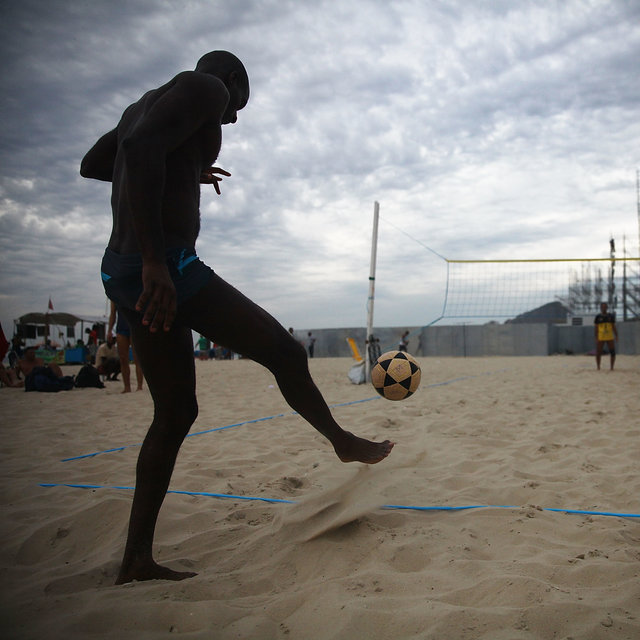Footvolley: Volleyball Played with Feet on the Beach
If you’ve ever strolled along the sun-kissed shores of a beach and witnessed an energetic and skillful game that looks like a fusion of soccer and volleyball, you’ve probably encountered footvolley. This thrilling sport has gained popularity around the globe, captivating both players and spectators with its dynamic nature and impressive displays of agility. In this article, we’ll explore the origins, rules, and unique aspects of footvolley, shedding light on why it has become a beach sensation.
The Origins of Footvolley
The roots of footvolley can be traced back to Brazil, where it emerged as a fun and informal beach activity in the 1960s. Brazilians, known for their passion for soccer and beach culture, naturally gravitated towards creating a game that combined elements of both. As the sport evolved, it gained structure and rules, eventually formalizing into the footvolley we know today.
How Footvolley is Played
Similar to beach volleyball, footvolley is typically played on a sandy court divided by a net. The main twist? Players are not allowed to use their hands; instead, they must use their feet, head, knees, and any other part of the body except for the hands to keep the ball in play. The game is fast-paced, requiring a combination of soccer skills, precise ball control, and the strategic teamwork seen in traditional volleyball.
Teams, usually consisting of two players each, strive to score points by landing the ball in the opponent’s court. The rally continues until a team fails to return the ball within the boundaries, resulting in a point for the opposing side. With its fluid and acrobatic movements, footvolley showcases the athleticism and creativity of its players.
The Global Spread of Footvolley
What started as a beach pastime in Brazil has now become a global phenomenon. Footvolley has gained popularity on the beaches of Europe, Asia, North and South America, and beyond. Tournaments and leagues attract skilled players who compete at a high level, captivating audiences with their incredible feats of footwork and ball control. The sport has even found its way into international competitions, showcasing its universal appeal.
Footvolley Rules and Regulations
While footvolley shares similarities with traditional volleyball, it has its own set of rules that make it a distinct and exciting game. The key regulations include:
- No Hand Contact: Players are strictly prohibited from using their hands or arms to touch the ball during play. This adds an extra layer of difficulty and requires players to rely on their feet and other body parts for ball manipulation.
- Scoring System: Footvolley typically follows a rally scoring system, where points are scored on every play, regardless of which team served. The first team to reach a predetermined number of points wins the set.
- Touches Per Team: Similar to volleyball, a team is allowed a specific number of touches (usually three) to return the ball over the net. Coordination and communication between teammates are crucial to ensure a successful play.
- Net Height: The net height in footvolley is the same as in beach volleyball for men and women. This standardization maintains consistency and ensures a level playing field for all participants.
Frequently Asked Questions (FAQs)
Q1: Is footvolley played professionally, and are there international competitions?
Yes, footvolley has evolved into a professional sport with numerous national and international competitions. Countries such as Brazil, Portugal, and Italy have well-established professional leagues, and the sport has also been featured in events like the Footvolley World Cup.
Q2: Do footvolley players have a soccer or volleyball background, or both?
Footvolley players often have a background in either soccer or volleyball, but many excel in both sports. The fusion of skills from these disciplines is what makes footvolley unique, requiring a combination of soccer’s footwork finesse and volleyball’s strategic play.
Q3: Can anyone play footvolley, or is it limited to skilled players?
Footvolley welcomes players of all skill levels. While professional competitions showcase elite athletes, beaches around the world host casual footvolley matches where enthusiasts can enjoy the game without the pressure of competition. It’s a sport that encourages both skill development and recreational enjoyment.
In conclusion, footvolley has transcended its Brazilian origins to become a global sensation, captivating beachgoers and sports enthusiasts alike. With its dynamic gameplay and emphasis on footwork, this unique blend of soccer and volleyball offers an exciting alternative for those seeking a thrilling beach experience. Whether you’re a seasoned player or a spectator eager to witness impressive athletic feats, footvolley delivers a dose of sun-soaked excitement on sandy shores worldwide.

